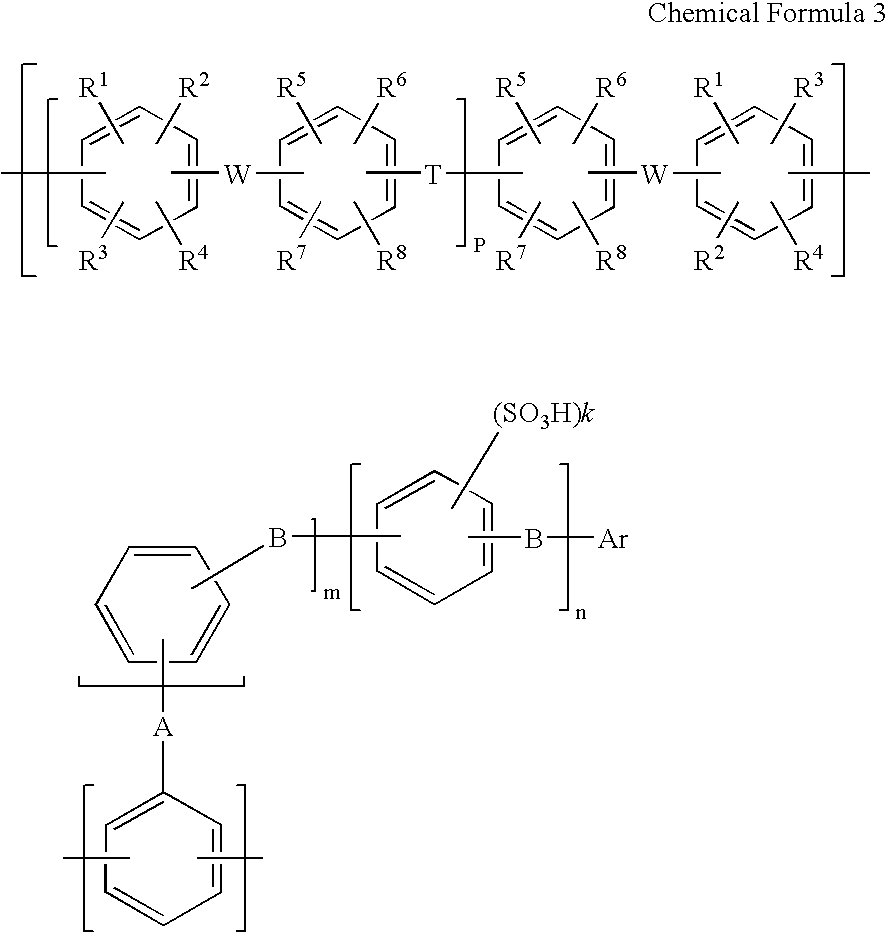Membrane electrode assembly and polymer electrolyte fuel cell therewith
a technology of membrane electrodes and fuel cells, applied in the direction of cell components, final product manufacturing, sustainable manufacturing/processing, etc., can solve the problems of ion conductivity greatly deterioration, air pollution and global warming caused by fossil fuel consumption, etc., to achieve superior electric power generation properties, control the deterioration of ion conductivity, and the effect of superior starting characteristics
- Summary
- Abstract
- Description
- Claims
- Application Information
AI Technical Summary
Benefits of technology
Problems solved by technology
Method used
Image
Examples
synthesis example 1
Preparation of Oligomer
[0122] 67.3 g (0.20 mol) of 2,2-bis(4-hydroxyphenyl)-1,1,1,3,3,3-hexafluoropropane(bisphenol AF), 60.3 g (0.24 mol) of 4,4-dichloro benzophenone(4,4′-DCBP), 71.9 g (0.52 mol) of potassium carbonate, 300 mL of N,N-dimethylacetamide (DMAc), and 150 mL of toluene were put in a 1 L three-neck flask equipped with a stirring device, thermometer, Dean-Stark tube, and three-neck cock to introduce nitrogen, and heated in an oil bath under a nitrogen atmosphere. The reaction was performed at 130° C. Removing water which was generated during the reaction by azeotropic distillation of toluene, to the outside of the reaction vessel using the Dean-Stark tube, and 3 hours later, generation of water was not significantly observed. The reaction temperature was slowly increased from 130° C. to 150° C., and most of the toluene was removed. After reacting for 10 hours at 150° C., 10.0 g (0.040 mol) of 4,4′-DCBP was added, and the reaction was further continued for 5 hours. After...
synthesis example 2
Preparation of Polyarylene Copolymer having Neo-Pentyl Group as a Protective Group (PolyAB—SO3neo-Pe))
[0124] 39.58 g (98.64 mmol) of 4-[4-[(2,5-dichlorobenzoyl)phenoxy]benzene sulfonic acid neo-pentyl (A-SO3neo-Pe), 15.23 g (1.36 mmol) of BCPAF oligomer, 21.67 g (2.55 mmol) of Ni (PPh3)2Cl, 10.49 g (40 mmol) of PPh3, 0.45 g (3mmol) of NaI, 15.69 g (240 mmol) of zinc powder, and 390 mL of dry NMP were put in a 1 L three-neck flask equipped with a stirring device, thermometer, Dean-Stark tube, and three-neck cock to introduce nitrogen. The reaction system was heated while stirring (heated up to a final temperature of 75° C.), and the reaction was continued for 3 hours. The polymerization reaction liquid was diluted by 250 mL of THF, and stirred for 30 minutes. Using celite as a filtering aiding agent, filtering paper and filtrate were in an excess amount of 1500 mL of methanol, to be congealed. The coagulation was collected, dried by air, dissolved in THF / NMP (each 200 / 300 mL) again,...
synthesis example 3
Preparation of Oligomer
[0127] Using 103.7 g (0.48 mol) of 4,4′-dihydroxybenzophenone (4,4′-DHPB), 148.2 g (0.52 mol) of 4,4′-dichlorophenylsulfone (4,4′-DCDS), 86.9 g (0.63 mol) of potassium carbonate, 500 mL of 1,3-dimethyl-2-imidazolidinone (DMI), and 200 mL of toluene, reaction operations were performed similar to those of Synthesis Example 1, and 180 g of compound was obtained (yield 78%).
[0128] Polystyrene converted number average molecular weight calculated by GPC (THF solvent) of the obtained polymer was 13,700. The obtained polymer can be dissolved in NMP, DMAc, DMI or the like. Tg of the polymer was 159° C. and the heat decomposition temperature was 500° C.
[0129] The obtained compound is estimated to be an oligomer having a structure shown in Chemical Formula 26 (hereinafter referred to as the C oligomer).
PUM
| Property | Measurement | Unit |
|---|---|---|
| thawing temperature | aaaaa | aaaaa |
| thawing temperature | aaaaa | aaaaa |
| temperature | aaaaa | aaaaa |
Abstract
Description
Claims
Application Information
 Login to View More
Login to View More - R&D
- Intellectual Property
- Life Sciences
- Materials
- Tech Scout
- Unparalleled Data Quality
- Higher Quality Content
- 60% Fewer Hallucinations
Browse by: Latest US Patents, China's latest patents, Technical Efficacy Thesaurus, Application Domain, Technology Topic, Popular Technical Reports.
© 2025 PatSnap. All rights reserved.Legal|Privacy policy|Modern Slavery Act Transparency Statement|Sitemap|About US| Contact US: help@patsnap.com



